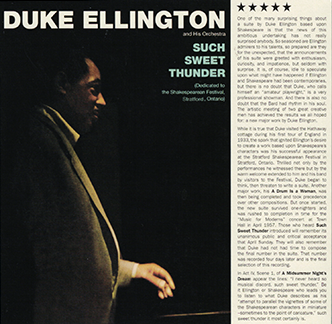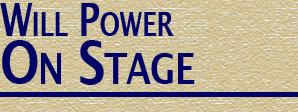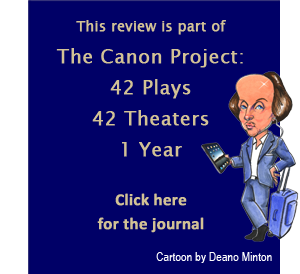Such Sweet Thunder
The Duke Finds Kindred Spirit in The Bard
Composed and orchestrated by Duke Ellington and Billy Strayhorn
Performed by Duke Ellington and his Orchestra
Produced by Irving Townsend
State of Art (CD); liner notes by Irving Townsend
"Dedicated to the Shakespearean Festival, Stratford, Ontario"
 In 1956, the four-year-old Stratford, Canada, Shakespeare Festival invited Duke Ellington and his orchestra to perform a series of concerts. Ellington's interaction with the festival's Shakespeare practitioners inspired him and his orchestrator, Billy Strayhorn, to compose Such Sweet Thunder, a suite of 12 songs based on Shakespeare's characters and the Bard himself. Ellington premiered the piece the following year.
In 1956, the four-year-old Stratford, Canada, Shakespeare Festival invited Duke Ellington and his orchestra to perform a series of concerts. Ellington's interaction with the festival's Shakespeare practitioners inspired him and his orchestrator, Billy Strayhorn, to compose Such Sweet Thunder, a suite of 12 songs based on Shakespeare's characters and the Bard himself. Ellington premiered the piece the following year.
Strayhorn contended that Ellington had "always been intrigued by Shakespeare, 'cause he said Shakespeare certainly knew more about people than anyone he had ever known. Duke also said that the only way Shakespeare could have known as much about people as he did was by hanging out on the corner or in the pool room. He says that if William Shakespeare were alive today, you would surely find him down at Birdland listening to jazz." This quote and others in this review come from the original liner notes by the recording's producer, Irving Townsend. Suite and original LP package are available on a State of Art CD version.
Ellington certainly knew Shakespeare, based on his insights in literally playing the playwright's characters.
- Such Sweet Thunder, leading off the suite, is based on "the sweet and swinging, very convincing story Othello told Desdemona," Ellington said. It is a slow, sultry jazz piece of mellow brass and woodwinds layered on a persistently steady beat with highlights of tinkering piano keys, wah-wah horns, and occasional bursts of brass. Its title, however, comes from A Midsummer Night's Dream, where Hippolyta describes how she's "never heard so musical a discord, such sweet thunder." She's talking about baying hounds, but Ellington builds on the Amazon queen's weather imagery to create a suitably seductive musical effect on behalf of Othello courting Desdemona.
- Sonnet for Caesar is the first of four pieces Ellington scored to represent Shakespeare's 14-line sonnet format. For Caesar, a piano intro sets a solemn theme, with woodwind solos on a funereal backing of horns. After the horns fade out the woodwinds converse in confused tones. I have to admit I can't make out the sonnet's rhythmic structure or rhyming sequences in Ellington's interpretation.
- Sonnet to Hank Cinq uses a saxophone and trombone duet in a soft-shoe melody to profile the young Hal and future Henry V as a jesting playboy. At 90 seconds, it is the suite's shortest piece.
- Lady Mac seems to cast the Thane of Cawdor's wife as a jazz club owner. Quoting Ellington: "Though she was a lady of noble birth, we suspect there was a little ragtime in her soul." It opens with a playful piano ragtime introduction before the orchestra arrives in a jazz waltz, surprisingly uplifting. The music seductively builds to an exclamation, then gives way to a clarinet expressing an insistent bit of temptation reinforced by an alto sax solo as the piano moodily tries to keep up. The rest of the instruments build to another climax, this time leading to a stabbing pair of eight-note sequences from the horns and a short phrase from the piano before the orchestra ends on a downbeat and resounding thud. "The ominous last chords speak of what else Lady Mac had in her soul," Townsend writes.
- Sonnet in Search of a Moor starts with an introspective tickling of the piano keys up the scales. When the right hand reaches the highest scale, it is juxtaposed with left hand notes at the lower scales before settling into a neutral refrain. The double bass then leads solemn clarinets into uncertain and perhaps suspicious phrasings as the bass ironically provides a lighthearted lead until it suddenly ends on a single troubling note.
- The Telecasters is a juxtaposition of the three witches from Macbeth with Iago from Othello. The witches, represented by three trombones, announce their presence in a four-note burst before the double bass pushes the tune along. Suddenly, Iago, played by a baritone sax, arrives in a mood of sly confidence and, with trombone underpinning, plays a tuneful six-note melody interrupted by four-beat silent pauses. The saxophone meanders through a solo that is both endearing and menacing with the trombones in full support, then suddenly blaring that four-note burst one last time.
- Up And Down, Up And Down (I Will Lead You Up And Down). Puck's strategy for confusing the Athenian lovers in the woods is played out in a dizzying arrangement of instruments representing the three couples caught up in the fairy's web of mischief. Demetrius and Helena are a clarinet and violin, Lysander and Hermia are alto and tenor saxophones, and the king and queen of the fairies, Oberan and Titania, are alto and valve trombone. Trumpeter Clark Terry plays Puck, making witty comments throughout and ending by trumpeting a laugh-out-loud "Lord what fools these mortals be."
- Sonnet for Sister Kate is evidence of Ellington's own timelessness as he recognizes in 1957 what's going on in Kate's mind more than most men a half-century later. A bothered piano opens the piece before a trombone-with-plunger begins the tune. It's a comical sound, yet the underpinning woodwinds create an air of sadness leading to a downbeat finish on the piano.
- The Star-Crossed Lovers opens with a symphonic piano and moves into a smooth seductive duet of alto sax (Juliet) and tenor sax (Romeo) engaging in a flirtatious conversation against a full orchestra landscape. Given all the sexy interplay going on with bending notes and thrilling climaxes, this could be a musical interpretation of the balcony scene. But I'm thinking it is the wedding night, the devirgination of both individuals that Shakespeare didn't dare stage.
- Madness in Great Ones showcases, again, Ellington's insightful take on Shakespeare's creations. His interpretation of Hamlet's madness is not a sulking prince but a playful prankster. His melodic dancing skills are on display, and the various horns are musical versions of excited dogs at a dog park, all starts and stops, wagging tails, conversation and consternation. Then the incomparable Cat Anderson takes over with a trumpet solo I can hardly imagine even as I'm listening to it, concluding like a bird tweeting and peeping its last words and then—silence.
- Half the Fun, with its opening percussion sequence suggesting an exotic locale, envisions the mystical romantic rendezvous of a queen and her legionnaire lover on a barge plying the Nile. An ecstatic solo sax, emerging from a horny foundation, climaxes to a pounding piano response, all amid breezy winds on a swaying bed of strings. The arrangement consummates on a single, satisfying piano note. While Ellington has Romeo and Juliet experiencing the thrills of new love, he portrays Antony and Cleopatra enjoying the breadth and depth of experienced love. At 4:21, it is the longest piece of the suite (outlasting "The Star-Crossed Lovers" by 20 seconds; just saying).
- Circle of Fourths concludes Ellington's Shakespearean tribute with a short jazz portrait of the Bard himself. Saxophonist Paul Gonsalves scats through Shakespeare's four genres represented in this suite—tragedy, comedy, history, and sonnets—progressing by the interval of a fourth through every musical key. It's crazy but structured, scored yet improvisational, dramatic and fun, with distinct characters in multiple plots reaching an intertwined culmination and a final speech. It's just so Shakespeare.
Eric Minton
October 11, 2025
Comment: e-mail editorial@shakespeareances.com
Start a discussion in the Bardroom




 Find additional Shakespeareances
Find additional Shakespeareances